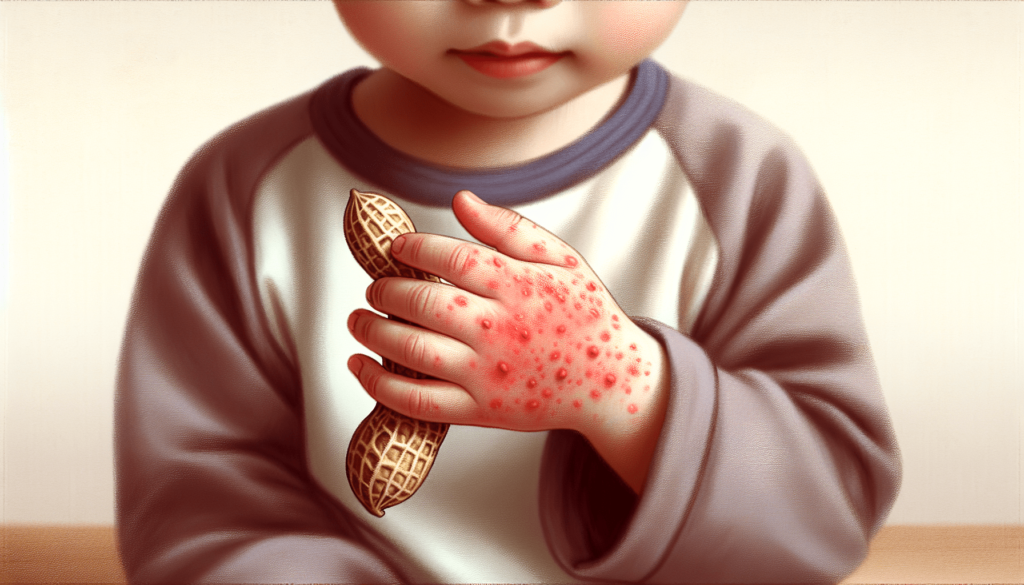Welcome to “Common Food Allergy Symptoms to Look Out For.” In this article, you will discover the various signs and symptoms that might indicate a food allergy, helping you to stay informed and prepared. From mild reactions such as itching and hives to more severe symptoms like difficulty breathing and anaphylaxis, knowing what to watch out for can make all the difference in managing your health or supporting a loved one. Explore the crucial indicators that could signal a food allergy and learn how to respond effectively, ensuring a safer and healthier lifestyle. Ever wondered if some of the discomforts you experience after eating certain foods could be related to food allergies? You’re not alone. Food allergies can be tricky to navigate, and knowing the common symptoms to look out for can help you manage your diet and overall health more effectively.
Introduction
Food allergies occur when your immune system mistakenly identifies certain proteins in foods as harmful substances. The body’s immune response to these proteins can trigger a range of symptoms, from mild discomfort to severe, life-threatening reactions. It’s essential to recognize these symptoms early to seek appropriate medical attention and avoid potentially dangerous situations.
Common Symptoms of Food Allergies
Food allergies can manifest in various ways. Here, you’ll find a comprehensive breakdown of the most common symptoms associated with food allergies. These symptoms are broadly categorized into three groups: skin reactions, gastrointestinal symptoms, and respiratory issues.
Skin Reactions
Skin reactions are among the most noticeable signs of a food allergy. They can occur within minutes to hours after consuming the allergenic food.
- Hives (Urticaria): These are raised, red, itchy welts that appear on the skin’s surface. Hives can be as small as a pencil eraser or as large as a dinner plate and may merge to form larger welts.
- Eczema (Atopic Dermatitis): This chronic skin condition can flare up due to food allergies, resulting in dry, itchy, and inflamed skin.
- Angioedema: This refers to swelling beneath the skin, often occurring around the eyes, lips, and face but can affect the throat and limbs.
Gastrointestinal Symptoms
Your digestive system is also commonly affected by food allergies. These symptoms can severely impact your daily life and overall health.
- Nausea and Vomiting: Feeling nauseous or vomiting soon after eating is a clear sign that your body is rejecting something.
- Abdominal Pain and Cramping: This could be a sign of inflammation in your digestive tract due to an allergic reaction.
- Diarrhea: Loose, watery stools can occur as your digestive system tries to expel the allergenic food.
Respiratory Issues
Respiratory symptoms can be especially concerning as they can escalate quickly and become life-threatening.
- Runny or Stuffy Nose: Nasal congestion or a runny nose can be a mild but common symptom.
- Coughing and Sneezing: Persistent coughing or sneezing can indicate that your body is reacting to an allergen.
- Wheezing and Shortness of Breath: These are more severe symptoms that can signal the onset of anaphylaxis. Immediate medical attention is required if you experience these symptoms.

Severe Reactions: Anaphylaxis
Anaphylaxis is a life-threatening allergic reaction that requires immediate medical attention. It’s crucial to recognize the signs and know how to respond. Symptoms usually occur within minutes of exposure to the allergen but can sometimes be delayed.
Signs of Anaphylaxis
Anaphylaxis symptoms can include several of the common symptoms listed above, but they escalate much more rapidly and severely:
- Difficulty Breathing: Severe constriction of the airways causing breathing difficulties.
- Drop in Blood Pressure: This can lead to shock, characterized by dizziness, lightheadedness, and fainting.
- Rapid Pulse: Your heart rate will increase as your body tries to counteract the reaction.
- Loss of Consciousness: In extreme cases, anaphylaxis can cause you to lose consciousness.
Emergency Response for Anaphylaxis
If you or someone around you is experiencing anaphylaxis, immediate action is crucial.
- Administer Epinephrine: If available, use an epinephrine auto-injector (such as an EpiPen) to counteract the reaction.
- Call Emergency Services: Dial emergency services right away to get professional medical help.
- Stay Calm and Monitor Symptoms: Keep the person as comfortable as possible while waiting for emergency responders.
Common Food Allergens
Some foods are more likely to cause allergic reactions than others. Knowing these common triggers can help you manage your food choices more wisely.
The Big Eight
The most common food allergens, often referred to as “The Big Eight,” account for about 90% of all food allergies.
| Allergen | Common Foods |
|---|---|
| Milk | Milk, cheese, yogurt, butter |
| Eggs | Egg whites, egg yolks, cakes |
| Peanuts | Peanut butter, peanut oil |
| Tree Nuts | Almonds, walnuts, cashews |
| Soy | Tofu, soy milk, soy sauce |
| Wheat | Bread, pasta, cereals |
| Fish | Salmon, tuna, cod |
| Shellfish | Shrimp, crab, lobster |
Other Notable Allergens
Apart from the Big Eight, other foods can also cause allergic reactions:
- Sesame Seeds: Common in Middle Eastern cuisine and baked goods.
- Mustard: Found in mustard seeds, mustard powder, and mustard oil.
- Corn: Corn starch, corn syrup, and cornmeal can all trigger allergies.

Diagnosis and Testing
If you suspect you have a food allergy, seeking a professional diagnosis is essential. Here, we’ll go through the main methods healthcare providers use to diagnose food allergies.
Medical History and Symptom Diary
Your doctor will likely start by asking about your medical history and a detailed account of your symptoms. Keeping a symptom diary that tracks what you eat and how you feel afterward can be extremely helpful.
Skin Prick Test
In this test, tiny amounts of common allergens are applied to your skin, usually on your forearm or back. Your skin is then pricked to allow the allergen to enter the surface layer. If you’re allergic, you’ll develop a raised, red spot at the test site.
Blood Test
A blood test known as a RAST (RadioAllergoSorbent Test) or an ELISA (Enzyme-Linked Immunosorbent Assay) can measure the amount of allergen-specific antibodies in your blood. Elevated levels indicate an allergic response.
Oral Food Challenge
This is considered the most accurate test but also the riskiest. Under strict medical supervision, you’ll consume the suspected allergen in increasing amounts to see if it triggers a reaction.
Management and Treatment
Managing food allergies involves both short-term measures to deal with immediate reactions and long-term strategies to avoid triggers.
Avoidance
The most effective way to manage a food allergy is to avoid the allergenic food entirely. This means reading food labels diligently and asking about ingredients when dining out.
Medications
Over-the-counter antihistamines can relieve mild allergic reactions such as hives or itching. For severe reactions, carrying an epinephrine auto-injector is crucial.
Allergy Action Plan
Having an allergy action plan can help you and those around you know what to do in case of an allergic reaction. This plan should include:
- Identifying Symptoms: Be aware of symptoms that signal a mild reaction versus those indicating anaphylaxis.
- Immediate Actions: What to do first, like taking antihistamines or using an epinephrine auto-injector.
- Emergency Contacts: Have a list of essential contacts, including doctors and emergency services.
Living with Food Allergies
Living with food allergies requires careful planning and vigilance, but it doesn’t mean you can’t enjoy a diverse and satisfying diet.
Education and Support
Educating yourself about your food allergies and seeking support from healthcare providers, family, and friends is crucial for managing your condition effectively. Joining support groups can also provide valuable resources and a sense of community.
Nutrition and Alternatives
Eliminating food allergens often removes essential nutrients from your diet. Consult a dietitian to identify safe, nutritious alternatives that ensure you’re getting a balanced diet. For example, if you’re allergic to dairy, almond or soy milk can be excellent substitutes.
Dining Out
Eating out can be challenging but not impossible. Here are a few tips to make it safer:
- Research Restaurants: Some establishments are more allergy-friendly than others. Look for places with good reviews on allergy accommodations.
- Speak Up: Inform the restaurant staff about your allergy and ask about ingredient lists and preparation methods.
- Avoid Buffets: Cross-contamination is highly likely in buffets where utensils might be used for multiple dishes.
Safe Cooking Practices
To minimize the risk of cross-contamination at home, follow these safety practices:
- Separate Utensils: Use designated utensils for preparing allergy-free meals.
- Clean Surfaces: Ensure cooking surfaces and utensils are thoroughly cleaned before use.
- Label Foods: Clearly label containers and packages with potential allergens to avoid accidental consumption.
Awareness and Advocacy
Raising awareness about food allergies can lead to a more informed and supportive community. Here’s how you can contribute:
Educational Talks
Consider giving educational talks at schools, workplaces, or community centers to spread awareness about the importance of understanding and managing food allergies.
Social Media
Use social platforms to share your experiences, tips, and resources about living with food allergies. This can help create a broader network of informed individuals.
Support Legislation
Advocate for policies that support food allergy labeling, safe food handling practices, and the availability of epinephrine auto-injectors in public places.
Conclusion
Understanding the common symptoms of food allergies and how to manage them is vital for your health and well-being. By identifying the symptoms, seeking proper diagnosis, and following management strategies, you can lead a fulfilling life even with food allergies. Remember, you’re not alone in this journey, and with the right knowledge and resources, you can successfully navigate the challenges food allergies present. Stay informed, stay safe, and continue to be proactive in managing your health.
